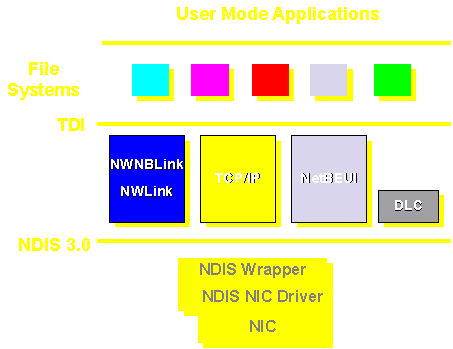

Windows NT ships with four protocols: Data Link Control (DLC), Transmission Control Protocol/Internet Protocol (TCP/IP), NWLink, and NetBEUI.
Unlike the other protocols in Windows NT (NWLink,TCP/IP, and NetBEUI), the DLC protocol is not designed to be a primary protocol for use between PCs. DLC only provides applications with direct access to the data link layer, and thus is not used by the Windows NT redirector. Because the redirector can not use DLC, this protocol is not used for normal session communication between Windows NT computers.
The DLC protocol is primarily used for the following two reasons:
Network-attached printers such as the HP® IIIsi use the DLC protocol because the frames received are very easy to take apart and because DLC functionality can easily be coded onto ROM.
DLC only needs to be installed on computers performing the above tasks and not on the other computers on the network. An example would be a print server sending data to a network HP printer. Client computers sending print jobs to the network printer do not need to be using the DLC protocol; only the print server communicating directly with the printer needs the DLC protocol installed.
The registry location for DLC parameters is HKEY_LOCAL_MACHINE\System\CurrentControlSet\Services\DLC.
TCP/IP stands for Transmission Control Protocol/Internet Protocol and is an industry-standard suite of protocols designed for wide-area networking. It was developed in 1969, resulting from a Defense Advanced Research Projects Agency (DARPA) research project on network interconnection.
DARPA developed TCP/IP to connect its research networks together. This combination of networks continued to grow and now includes many government agencies, universities, and corporations. This global area network is referred to as the Internet.
Windows NT TCP/IP allows users to connect to the Internet as well as any machine running TCP/IP and providing TCP/IP services.
Advantages of the TCP/IP protocol include:
The registry location for TCP/IP parameters is HKEY_LOCAL_MACHINE\System\CurrentControlSet\Services\Tcpip.
NWLink is an IPX/SPX-compatible protocol for Windows NT. It can be used to establish connections between Windows NT computers and MS-DOS, OS/2, Windows, or other Windows NT computers through a variety of communication mechanisms.
NWLink is simply a protocol. By itself, it does not allow a Windows NT computer to access files or printers on a NetWare server, or to act as a file or print server to a NetWare client. To access files or printers on a NetWare server, you must use a redirector, such as Microsoft's Client Service for NetWare (CSNW) or Novell's NetWare Client for Windows NT.
NWLink is useful if you have NetWare client-server applications that use sockets or NetBIOS over the IPX/SPX protocol. The client portion can be run on a Windows NT computer accessing the server portion on a NetWare server or vice versa. NWNBLink contains Microsoft enhancements to Novell's NetBIOS. The NWNBLink component is used to format NetBIOS-level requests and pass them to the NWLink component for transmission on the network.
The registry location for NWLink parameters is
HKEY_LOCAL_MACHINE\System\CurrentControlSet\Services\NWLINK.
NetBEUI stands for NetBIOS Extended User Interface, and was first introduced by IBM in 1985. NetBEUI was developed for small departmental LANs of 20-200 computers. It was assumed that these LANs would be connected by gateways to other LAN segments and mainframes.
The version of NetBEUI shipping with Windows NT is NetBEUI 3.0. It contains the following features:
The registry location for NetBEUI parameters is HKEY_LOCAL_MACHINE\System\CurrentControlSet\Services\Nbf.
Strictly speaking, NetBEUI 3.0 is not truly NetBEUI because it is not inherently extending the NetBIOS interface. Instead, its upper level interface conforms to the Transport Driver Interface (TDI). However, NetBEUI 3.0 still uses the NetBIOS Frame Format (NBF) protocol and is completely compatible and interoperable with previous versions of NetBEUI.
The NetBIOS Interface provides the NetBIOS mapping layer between NetBIOS applications and the TDI compliant protocols.
The NetBIOS Interface component can be configured in the Control Panel Network option.
A LANA number can be explicitly assigned to each network route. The network route is the protocol driver and network adapter that will be used for NetBIOS commands sent to its assigned LANA number.
The LANA number is important for MS-DOS NetBIOS applications that are hardcoded to use a specific LANA number for communicating on the network.